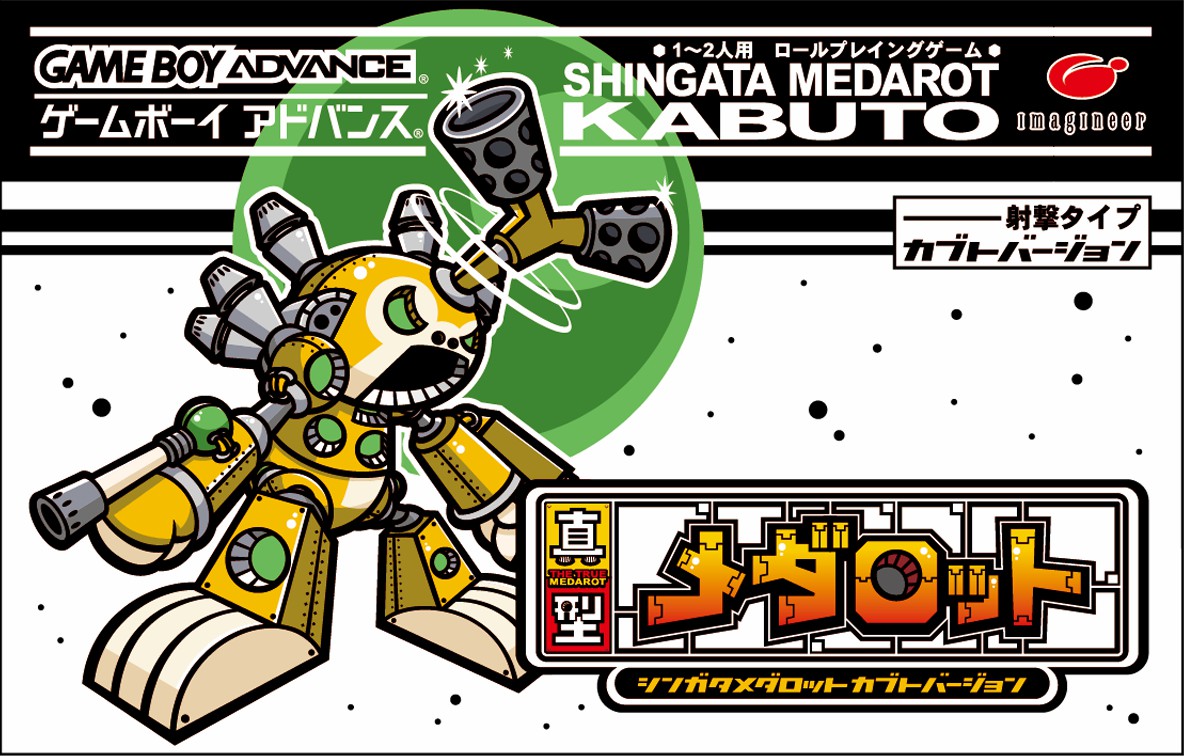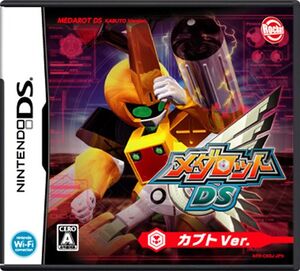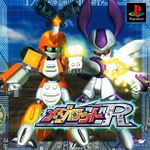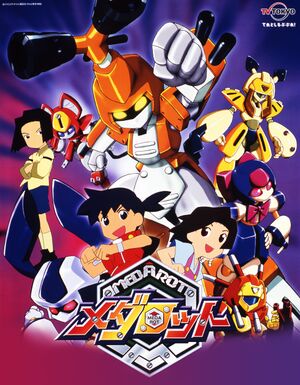Medarot (franchise)
This article requires improvements.
The following points of improvement have been raised:
-
Needs more information on the manga, merchandise and especially the TCGs

Medarot (メダロット, known internationally as Medabots) is a media franchise created and owned by Japanese game publisher Imagineer based on the story concepts and designs of mangaka Horuma Rin. The series centers around the titular Medarots, small modular robots of alien origins that are fully obedient to their human masters and are used in fights know as Robattles. Though its main component is a series of turn-based role playing video games released mainly for Nintendo handheld consoles, Medarot was conceived as a multimedia franchise from the onset and also seen an extensive history in manga, merchandising and two anime series. The games were developed by game company Natsume until 2003, after which development was taken over by a succession of Imagineer subsidiaries, namely Rocket Company, Delta Arts and So What. ¸
Since its inception in 1997, the franchise has run more or less continuously barring a hiatus between 2005 and 2010. Most installments have been exclusively released in Japan, although a few were localized in the early 2000s and others have since been translated unofficially by fan groups. By March 2015, the series had sold over 3 million copies worldwide
Common elements[edit]
Story and characters[edit]

Medarot takes place in near-future Japan, where a worldwide sensation known as the Medarots has changed everyday life. Medarots are sapient, usually around one meter-tall robots (though some larger models exist) built around a durable endoskeleton called a Tinpet. Tinpets allow for modular building, allowing Medarots to have any combination of head, left arm, right arm, and legs barring restrictions tied to the Tinpet's gender. Medarots are powered by Medals inserted in a slot on the Medarot's back, which hold the Medarot's consciousness and memories. Medarots receive commands from their owners through a device called the Medarotch and can partake in Robattle where tradition has the winner of a bout get a random medarot part from the loser, though a series of restrictions known as The Three Laws of Medarots (inspired by Isaac Asimov's Three Laws of Robotics) limits a Medarot's ability to cause serious harm.
The series constantly change casts and location and thus does not a defined "main" protagonist though Ikki Tenryou (who stars in Medarot 2-4 as well as their derived anime and manga adaptations) is the most recurring and recognizable. Recurring elements include a male (usually elementary school-grade or young teenage) protagonist, his female childhood friend, costumed troublemakers (usually the RoboRobo Gang or derived groups), an incompetent police force (usually the Select Corps) and a duo or trio of school bullies.
Most Medarot media is aimed at young children and thus stories are typically lighthearted and comedic in tone, although some installments have explored serious themes. For instance, Medarot 4 was described by its writer as intentionally pushing the boundaries of what Nintendo would allow for release on its consoles.
The Medarots[edit]

The titular Medarots are the cornerstone of the franchise, with gameplay and marketing encouraging collection of all Medarot parts within a given game. Medarots are gendered between Male and Female Tinpets and male parts cannot be put on a female Tinpet or vice-versa, though a number of gender-neutral parts exists. The Medarots are stated in backstory to have an alien origin, with different tellings having their Medals brought to Earth by an alien comet for a mysterious purpose, or being the mechanized remains of the survivors of an extinct civilization.
Over 1000 different Medarot models have been introduced since the series' inception, most of them originating from the games but a handful being original to the various manga and anime series. Early installments in the game series took different approaches to curating the Medarot roster; while Medarot 2 allowed players to transfer their team from the first game (although most models were redundant against their statistically-superior successors), Medarot 5 dispensed with returning models entirely, having its roster entirely composed of new Medarots. Since the release of Medarot DS, there has been a greater effort to balance keeping popular models alongside introducing new faces.
At various times, Imagineer has sollicited fans to submit their original Medarot designs (or "Orimeda") through magazine postings (X-Project) or social media posts, with winning entries being canonized as official Medarot designs in the games.
Gameplay[edit]
Format[edit]
The mainline Medarot games are turn-based role playing games. Gameplay is divided in two phases: overworld and battles. On the overworld, players control a human Medarotter from an overhead view where they can move around, talk to NPCs, interact with objects and manage their Medarot roster. Stories are typically linear in nature, although the games often incorporate sidequests and some of the mainline installments include hidden romancing mechanics where the player can end up between one of two women based on their actions and dialogue options selected throughout the game, with different events and parts rewarded for their choices.
Most Medarot games are released in dual Kabuto and Kuwagata versions, with their own starter robots and set of parts and medals. Kabuto starters are typically yellow, modeled after Japanese rhinoceros beetles and focused on shooting attack, while Kuwagata-type starters are white, based on stag beatles and focused on melee attacks. Players are encouraged to trade with players owning the other version to be able to acquire a full set of parts, and early releases also had supplemental Parts Collections games, short plot-light sidegames that provide an alternate way to collect all parts for their parent titles.
While on the overworld, players can check their inventory, save, and assemble Medarots. Parts are obtained by winning battles, purchasing them at shops (with currency being acquired through plot events or selling parts), acquiring them through plot progression or by finding them in the field. Players typically start with one Tinpet and collect more through story progression and sidequests, usually to a maximum of nine. Beside assembling a Medarot's parts, another component to consider is its Medal. In gameplay terms, the Medal dictates what stats a Medarot's specialize in and what parts it prioritize when attacking, though the specifics of the system have changed over time.
Battle system[edit]

Battles in Medarot take the form of turn-based battle. Battle starts with the player selecting their Medarot team composition and giving each Medarot a command, equivalent to one of its parts. Arm parts actions typically have unlimited ammo, while Head actions are often more potent but have limited uses. Bouts are represented as a sort of relay race where each side's Medarot runs to a central point known as the Active Line, execute their action and then move back to their starting point to repeat the process, a phase known as Cool Down.
Each Medarot parts has its own health point values and when it is depleted, the part is destroyed and actions tied to it can no longer be used. Battles are won by taking out the designated enemy Leader. A Medarot is defeated when its Head part is destroyed, irrespective of the status of its other components.
Attacks are divided into a variety of Skils with differing properties. For instance, Melee attacks will strike whichever opposing Medarot is closest to the Active Line, while Shooting attacks can aim at a specific Medarot but will not work if the targeted part has already been destroyed by the time of the attack's execution.
Mainline games[edit]
Debut games[edit]

Medarot 1 was the first installment in the series, released in 1997 for the Game Boy. The game tells the story of Hikaru Agata as he explores the region for his summer vacation and comes in conflict with the RoboRobo Gang. As the start of the series, Medarot sets the basics that would be followed in most of the following games but lacks or implement some systems differently.
In anticipation of the upcoming release of Medarot 2 and its anime adaptation, a remake was released in 1999 for the Wonderswan handheld, under the title Medarot Perfect Edition. Perfect Edition keeps the gameplay largely the same but makes various quality of life improvements and adds extra scenes and dialogue to flesh out the story. Another, much more liberal remake was released under the title Shingata Medarot in 2004 for the Game Boy Advance.
Ikki Tenryou games[edit]
1999 would see the release of the series best-selling installment in Medarot 2. Taking place seven years after the events of the original game, Medarot 2 stars a new protagonist, schoolboy Ikki Tenryou who is dragged into adventure when he is forced by an older Hikaru into purchasing his own Medarot. The game introduced the concept of Medaforce, allowing Medarots to charge energy to unleash a variety of powerful techniques.
It was followed in 2000 with Medarot 3 for the Game Boy Color. New features include Medachange (Medarot part sets that have the ability to transform, giving them new properties and attacks) and Medalias, small jewels that can be inserted in three indents on Medals to increase its skills. The game incorporate themes about the environment and was the final release to have a companion Parts Collection title.
Medarot 4 was released in 2001. Advertised as the end of Ikki's story, its plot has Ikki rescue Karin from a sinister group of Medarotters known as the Four Kings. Its gameplay reuses the system of Medarot 3 but incorporate more minigames.
To capitalize on the western localization of the anime series, Medarot 2 was remade as Medarot 2 Core (simply "Medabots" internationally) for the GameBoy Advance in 2003. The game is a faithful remake of its parent title, but has a modernized battle system and makes various changes to the design and Medarot roster to match the anime series.
Interim era[edit]

Medarot 5 launched late in 2001 for the Game Boy Color, bringing another major shake up with a new cast, setting and roster of Medarots. Its plot stars schoolboy Koishimaru Tensan as he moves into a new town and acquires an abandoned Medarotch. Though Medarot 5 is the only RPG title to start Koishimaru, its story is continued in the fighting game spin-off Medarot G.
2004 would mark the first entry to developed internally at Imagineer with Shingata Medarot (lit "True Type Medarot") for the Game Boy Advance. Ostensibly a remake of the first Medarot, Shingata takes a much looser to remaking its parent title than Perfect Edition, featuring a brand roster of Medarots and a overhauled art style. The game was criticized for its art style and lack of innovation and sold very poorly which, along with a trend of declining sales for Medarot games, marked the end of the franchise for a time.
Azuma Amakura games[edit]

After five years of hiatus, Medarot would return in 2010 with Medarot DS for the Nintendo DS. The story has Azuma Amakura, a young boy who wants his Medarot but is not allowed to own one by his strict father, acquires one through a set of circumstances and gets tangled in an adventure with older incarnations of the cast of Medarot 2. Though criticized for its writing and issues with the battle system, Medarot S proved to be enough of a financial success to resume work on the series.
The series continued in 2012 with Medarot 7 for the Nintendo 3DS. The first fully 3D Medarot RPG, 7 is a retelling of DS, presenting a similar but irreconciliable storyline.
Later 3DS games[edit]
2014's Medarot 8 takes place in a new setting and features an entirely new cast, centering its plotline around protagonist Salt, who is part of a detective agency investigating odd occurences in town. The game makes many changes to the core battle system which would be carried over in future titles.
Medarot 9 is another shake-up, set in another setting as its protagonist Tenma enters a prestigious academy. New additions to the formula include the ability to select which parts the player wants to claim after winning a battle, and the ability to dynamically swap a part on the Leader Medarot once per battle.
Current era[edit]
2020 saw Medarot return to video games with Medarot S: Unlimited Nova, a mobile gacha game updated on a weekly basis, having adding a large number of new Medarots and features since its launch. Its story has another new protagonist Arase Oosumi, who is approached by a mysterious girl who lends him the medarot Cross Messiah. It is also notable for its large number of crossover events with other franchises, having held collaborations with properties such as Neon Genesis Evangelion, Ultraman and Transformers.
In a 2023 stream for Medarot S, Imagineer staff mentioned that development has started on a new Medarot project unrelated to Medarot S.
Spin-offs[edit]
RPGs[edit]

The first non-numbered Medarot RPG was Medarot R, released in 1999 for the Playstation. The game has a similar but distinct story from Medarot 2. Though still using 2D graphics for its overworld gameplay, Medarot R is the first installment to employ 3D graphics for its Robattles. It also had by far the biggest Medarot roster up to that point, featuring a total of 253 medarots both old and new. It is the only spin-off title to receive a Parts Collection expansion.
Shortly after Medarot 5, Medarot Navi marked the series debut on the GameBoy Advance platform. Sporting a more sleek and angular artstyle, Navi's gameplay employs 5v5 battles on large maps, playing more like a tactical turn-based RPG than the typical Medarot game.
Action games[edit]
The first Medarot game action game was Metabee Shot, a simple timing-based medal game released for Japanese arcades in 2001. The game has player control a Saikachis to attack and defend from enemy medarots using one-button controls.
2002's Medabots AX for GameBoy Advance was the first Medarot game released for western audiences, a 2D 2v2 platform fighter. In Japan, it was released as Medarot G, with redrawn graphics, a Medarot roster based on that of 5 and a story concluding the plot of that game.
Medarot Brave (Medabots Infinity internationally) launched on the Nintendo GameCube in 2003. The first fully 3D title in the series, Brave plays like an overhead shooter. Its plot has Ikki and Metabee investigate mysteries in a newly-opened amusement park. It was the final game to be translated for western audiences and also marks the end of Natsume's involvement with the series.
Medarot Dual hit the Nintendo 3DS in 2013. The game is a third-person 2vs2 arena fighter, playing similarly to titles such as the Gundam VS series. A sequel was released in 2015 under the title Medarot Girls Mission. As its title indicates, Girls Mission features an all-female cast and also boasts a more sexually-charged presentation, including a mechanic where players can damage the opponent's clothing by meeting certain conditions. As a result of its poor sales and declining performance of the 3DS Medarot titles, the game series saw another hiatus until 2020, although unlike the last time, the franchise would continue through manga and merchandising.
Compilations[edit]
A compilation titled Medarot Classics was released in 2017 for the Nintendo 3DS. It includes Medarot 1 to Medarot 5 and adds extra features such as the ability to speed up battle animations or use save states. An upgraded version titled Medarot Classics Plus followed in 2020 for the Nintendo Switch, adding the Game Boy Advance titles beside Shingata Medarot.
In other medias[edit]
Manga[edit]
Most of the Medarot mangas were published under Kodansha's Comic BomBom magazine. Not all runs were collected in volumes, making their availability limited. Of all manga series, only the Medarot 2 manga was officially localized in English, though the first manga also saw releases in France and Singapore.
The original Medarot manga by Horuma Rin was the first, debuting shortly before the game and running until 1999. It was succeeded by mangas based on Medarot 2, Medarot 3 and Medarot 4 (2001), forming a continuous narrative. After this, Homura Rin penned new runs based on Medarot 5 and Medarot G, and a Medarot DS manga in 2009.
Parralel to this, artist Fujioka Kenki penned Medarotter Rintarou! in 1998, telling the adventures of hyperactive Rintarou Namishima in an alternate universe from Homura Rin's manga series. The series was followed by Medarot R in 1999. Some of the elements from these series, most prominently Rintarou himself and the powerful Medarot Arcbeetle would be incorporated into other installments of the series. Fujioka later authored the manga adaption of Medarot Navi in 2001.
2017 saw the start of a new manga series titled Medarot Reloaded in a brand new universe not based on any of the games. Aimed at older audiences with a teenage protagonist and more explicit violence, it ran until 2023, making it by far the longest-running Medarot manga. A 2023 stream for Medarot S teased that a sequel is in development.
Anime[edit]

Shortly before the release of Medarot 2, a 52-episodes Medarot anime started airing on TV Tokyo, adapting its plot with some creative differences. It was followed in 2000 by Medarot Damashii, a sequel series produced by the studio Trans Arts. More of an original story, its plot has Ikki and an upgraded Metabee fight against Kokuryuu Kamizake and his sinister Death Medarots.
Both series would be localized by Canadian distributor Nelvana in 2001 under the title Medabots, being the first exposure to the franchise to many fans outside Japan.
Merchandise[edit]
Japanese toymaker Takara released a number of licensed Medarot products including, 2.5 inches figures, model kits and roleplay items. Takara's long-time western partner Hasbro would import many of its Medarot toys in the wake of the anime's western airing, although it would supplement these products with a number of new offerings, most prominently a line of 6 action figures with swappable limbs.
In 2014, model kit manufacturer Kotobuyika started a new line of Medarot model kits, with a number of releases up to the present day.